
Guam is an organized, unincorporated territory of the United States in the Micronesia subregion of the western Pacific Ocean. Guam's capital is Hagåtña, and the most populous village is Dededo. It is the westernmost point and territory of the United States, reckoned from the geographic center of the U.S. In Oceania, Guam is the largest and southernmost of the Mariana Islands and the largest island in Micronesia. As of 2022, its population was 168,801. Chamorros are its largest ethnic group, but a minority on the multiethnic island. The territory spans 210 square miles and has a population density of 775 per square mile (299/km2).
The history of Guam starts with the early arrival around 2000 BC of Austronesian people known today as the Chamorro Peoples. The Chamorus then developed a "pre-contact" society, that was colonized by the Spanish in the 17th century. The present American rule of the island began with the 1898 Spanish–American War. Guam's history of colonialism is the longest among the Pacific islands.
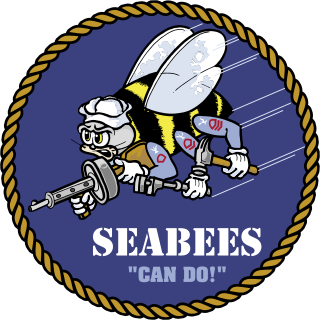
United States Naval Construction Battalions, better known as the Navy Seabees, form the U.S. Naval Construction Forces (NCF). The Seabee nickname is a heterograph of the initial letters "CB" from the words "Construction Battalion". Depending upon context, "Seabee" can refer to all enlisted personnel in the USN's occupational field 7 (OF-7), all personnel in the Naval Construction Force (NCF), or Construction Battalion. Seabees serve both in and outside the NCF. During World War II they were plank-holders of both the Naval Combat Demolition Units and the Underwater Demolition Teams (UDTs). The men in the NCF considered these units to be "Seabee". In addition, Seabees served as elements of Cubs, Lions, Acorns and the United States Marine Corps. They also provided the manpower for the top secret CWS Flame Tank Group. Today the Seabees have many special task assignments starting with Camp David and the Naval Support Unit at the Department of State. Seabees serve under both Commanders of the Naval Surface Forces Atlantic/Pacific fleets as well as on many base Public Works and USN diving commands.

The Mariana and Palau Islands campaign, also known as Campaign Plan Granite II, was an offensive launched by United States forces against Imperial Japanese forces in the Pacific Ocean between June and November 1944 during the Pacific War. The campaign consisted of Operation Forager, which captured the Mariana Islands, and Operation Stalemate, which captured Palau. Operation Causeway, the invasion of Taiwan was also planned but not executed. The offensive, under the overall command of Chester W. Nimitz, followed the Gilbert and Marshall Islands campaign and was intended to neutralize Japanese bases in the central Pacific, support the Allied drive to retake the Philippines, and provide bases for a strategic bombing campaign against Japan.

The Battle of Guam was the American recapture of the Japanese-held island of Guam, a U.S. territory in the Mariana Islands captured by the Japanese from the United States in the First Battle of Guam in 1941 during the Pacific campaign of World War II. The battle was a critical component of Operation Forager. The recapture of Guam and the broader Mariana and Palau Islands campaign resulted in the destruction of much of Japan's naval air power and allowed the United States to establish large airbases from which it could bomb the Japanese home islands with its new strategic bomber, the Boeing B-29 Superfortress.

The Special Naval Landing Forces were the marines of the Imperial Japanese Navy (IJN) and were a part of the IJN land forces. They saw extensive service in the Second Sino-Japanese War and in the Pacific theatre of World War II. While not explicitly referred to as "marines" by the IJN, they functioned as the professional infantry of the Navy, while engaging in many coastal or amphibious operations, leading to them generally being referred to as "Imperial marines" or simply "Japanese marines."

The Imperial Japanese Navy land forces were a variety of land-based units of the Imperial Japanese Navy (IJN) organized for offensive operations, the defense of Japanese naval and shore-based facilities, military policing tasks, construction and engineering, training, and shore-based anti-aircraft roles; both overseas, and in the Japanese home islands. Units ranged from dedicated military police formations, to ad-hoc groups of naval personnel pressed into service as naval infantry, to professional marines, among others. The land forces were most active during the interwar period and World War II, with IJN land forces complementing, supporting, and in some cases, operating in-place of Imperial Japanese Army units. Upon Imperial Japan’s defeat in WWII, IJN land forces were disbanded alongside the IJN proper in 1945.

Piti is a village located on the central west coast of the United States territory of Guam. It contains northern and eastern coastlines of Apra Harbor, including Cabras Island, which has the commercial Port of Guam and the island's largest power plants. Piti was a pre-Spanish CHamoru village and, after Spanish colonization, became the primary port town on Guam. The town was largely destroyed during the 1944 liberation of Guam and the population relocated during the wartime construction of Apra Harbor.

The War in the Pacific National Historical Park is a multi-unit protected area in the United States territory of Guam, which was established in 1978 in honor of those who participated in the Pacific Theater of World War II. Uniquely among the National Park System, it honors the bravery and sacrifices of all those who participated in the Pacific Theater.
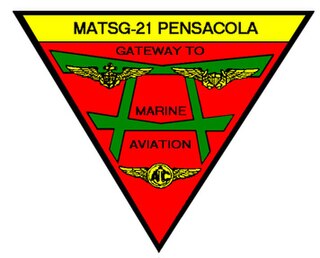
Marine Aviation and Training Support Group 21 (MATSG-21) is a United States Marine Corps aviation training group that was originally established in 1922 as the 2nd Aviation Group. During World War II the unit was known as Marine Aircraft Group 21 (MAG-21). Squadrons from MAG-21 fought in many of the opening battles of the war to include the Battle of Wake Island, Battle of Midway and as part of the Cactus Air Force during the Battle of Guadalcanal. The group was deactivated following the end of the war and was not reactivated until 2000 when the Marine Aviation Detachment at Naval Air Station Pensacola, Florida was renamed MATSG-21. The core of the MATSG personnel is derived from 175 officer instructors and 550 student naval aviators/naval flight officers.
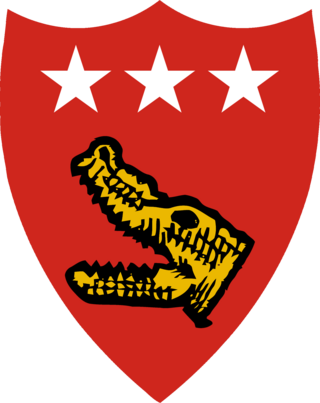
The V Amphibious Corps (VAC) was a formation of the United States Marine Corps which was composed of the 3rd, 4th and 5th Marine Divisions in World War II. The three divisions were the amphibious landing force for the United States Fifth Fleet with two goals, removal of Japanese forces from islands so U.S. Seabees could build advance bases to project US power. In doing this VAC was notably involved in the battles for Tarawa, Saipan, and Iwo Jima. V Amphibious Corps was commanded by General Holland 'Howlin Mad' Smith followed by General Harry Schmidt.

The Battle of Guam was an engagement during the Pacific War in World War II, and took place from 8 December to 10 December 1941 on Guam in the Mariana Islands between Japan and the United States. The American garrison was defeated by Japanese forces on 10 December, which resulted in an occupation until the Second Battle of Guam in 1944.

Marine Defense Battalions were United States Marine Corps battalions charged with coastal and air defense of advanced naval bases during World War II. They maintained large anti-ship guns, anti-aircraft guns, searchlights, and small arms to repel landing forces.

The 19th Marine Regiment was a composite engineer regiment of the United States Marine Corps subordinate to the 3rd Marine Division. It existed from September 1942 until September 1944. In December 1943 there was a large change of command in the regiment. Marine engineer regiments were eventually disbanded in favor of independent engineering battalions within the parent Marine divisions.

This is an order of battle listing the Allied and Japanese forces involved in the Battle of Arawe from 15 December 1943 to 24 February 1944.
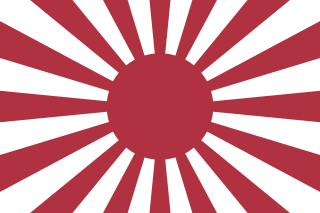
The Pacific War lasted from 1941 to 1945, with the Empire of Japan fighting against the United States, the British Empire and their allies. Most of the campaign was fought on a variety of small islands in the Pacific region. Compared to the Western-European Theater, combat in the Pacific was brutal, marked by illness, disease, and ferocity. The Imperial Japanese Army (IJA) typically fought alone in these engagements, often with very little naval or aerial support, and the IJA quickly garnered a reputation for their unrelenting spirit.
The 2nd 90mm Antiaircraft Artillery Gun Battalion was a United States Marine Corps antiaircraft unit that was active during the 1940s & 1950s. Originally formed during World War II as the 9th Defense Battalion, the battalion took part in combat operations on Guadalcanal, Rendova, Munda Point, and Guam. Like most other Marine defense battalions, the unit was re-designated in September 1944, becoming the 9th Antiaircraft Artillery Battalion. Returning to the United States in 1946, the battalion was again re-designated, this time as the 1st Antiaircraft Artillery Battalion. The battalion received its final designation as the 2nd 90mm Antiaircraft Artillery Battalion on August 21, 1950. It was later decommissioned on September 15, 1956, at Marine Corps Base 29 Palms, California.

United States Naval Hospital Guam is a U.S. Navy medical facility on the U.S. territory of Guam. It provides a broad range of medical services to active-duty U.S. military personnel under Joint Region Marianas. Besides the main hospital, the hospital runs a medical clinic and a dental clinic on Naval Base Guam.
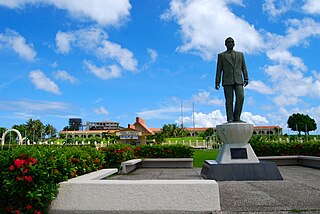
Adelup Point is limestone promontory in Hagåtña, Guam that extends into the Philippine Sea and separates Asan Bay from Hagåtña Bay. It has been the site of the Ricardo J. Bordallo Governor's Complex since 1990. Adelup is therefore a metonym for the Office of the Governor of Guam.

Liberation Day on the U.S. territory of Guam is an annual commemoration of the invasion by U.S. military forces on July 21, 1944, which ended the Japanese occupation that had begun in 1941. Begun in 1945, it is Guam's largest celebration. Festivities include a queen contest, summer carnival, fireworks display, and mile-long parade on Marine Corps Drive in Hagåtña from Adelup to Paseo de Susana, as well as solemn memorials and visits to massacre sites. It is organized by the Guam Island Fair Committee.